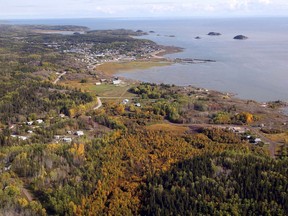Article author:
The Canadian Press
Bob Weber

Nature's greatest glory is processed oils I am back in Canada to assess the government's response to ongoing threats to the nation's largest national park, including plans to release sand tailings into the basin.
In a series of meetings starting Thursday, UNESCO investigators will decide whether Wood Buffalo National Park should be placed on the list of World Heritage Sites in Danger. has become probably.
"Canada is not doing well," said Melody Lepin of Mixeu Cree First Nation, who first brought concerns about parks in northern Alberta to UNESCO's attention.
Larger than Switzerland, the Wood Buffalo is he of one of the world's largest freshwater deltas and is rich in biodiversity, including nesting grounds for the endangered Whooping Crane. The labyrinth of wetlands, rivers, lakes and prairies is the largest and most pristine ecosystem in North America.
But the park, which straddles Alberta and the Northwest Territories, is slowly depleting due to a combination of climate change and upstream development such as the Site C dam in British Columbia. Similarly, research has found increasing evidence of infiltration into groundwater and surface waters upstream from oil sands tailings ponds.
In 2017, UNESCO found that 15 of the 17 ecological benchmarks within the park were deteriorating, indicating that the park needed to maintain its status. Provided Canada with a list of improvements. This week's meeting is to assess federal and state responses.
A report prepared for Mixeu by scientific consultant Carla Davidson noted that it was the state that created the buffer zone around the park, and Ottawa credited the water management plan within it. Admit it. But the documentation tells us that very little else has been done.
A risk assessment of the oil sands tailings has not yet begun, the report said. The location of the oil sands areas used by Whooping Cranes has not been determined.
Proposals from indigenous peoples to address knowledge gaps were rejected. There is no land use plan.
According to the report, state groups studying scientific issues are given restrictive terms of reference.
For example, groups studying mine landfills can only consider ways to treat and discharge wastewater. Cultural impacts on local indigenous peoples are not considered, nor are the cumulative impacts of individual developments.
"Alberta has so far refused to implement most (of the recommendations)," the report said. "Instead, we see many examples of Alberta relying on the very policy instruments that have brought the park to where it is today."
Preparing regulations to control the initial release of tailings. These regulations are scheduled for 2025.
Contaminated water should be safely treated and discharged, says the Canadian Mining Association. According to documents posted on the association's website, tailings ponds are renewable only after the water that fills them is removed. We have proven processes to treat these (pollutants) to levels that are safe for release into the environment," it said. “After decades of trying different methods in the field with the goal of constant improvement, the industry is convinced that once regulations are in place, water can be treated and safely released into the environment.
However, Jillian Chow Fraser of the Canadian Parks and Wilderness Society notes that both industry and government are seeking other ways to treat tailings, such as pumping water underground. He said he hadn't considered how.
"[Cure and Release] is not really a regenerative solution," she said. "It's a cheap and easy way for these companies to keep producing at the same rate."
"Processed oil and mine water that has come into contact with bitumen must be treated using rigorous science to ensure that it is safe to do so and that it is protected." It will not be released until we can clearly demonstrate that a rigorous regulatory process is in place – it's about human and ecological health," she wrote in an email.
If UNESCO puts Wood Her Buffalo on its "endangered" list, it would join 52 sites around the world, most of which are endangered by war or civil strife. I'm here. There is only one site from the G7 countries in the Florida Everglades.
"Being listed as a World Heritage Site is something we should be really proud of," said Chowfraser. "This international perception that things aren't as good here as they thought is nothing to be proud of." Not, she said Lepine. But addressing that problem and the overall deterioration of wood buffalo requires more resources and a broader search for solutions.
"They don't present different options," she said.
Lepine said a move from UNESCO might prompt the Canadian government to act.
"This site must be marked as 'Dangerous'.
This report by The Canadian Press was first published on August 17, 2022.

Sign up to receive daily top her stories from National Post, a division of Postmedia Network Inc.
Thank you for registering.
Sending welcome email. If you don't see it, please check your spam folder. The next issue of
NP Posted will arrive in your inbox shortly.


